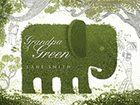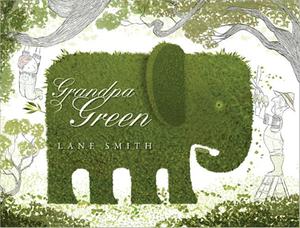
 In what may well be his greatest achievement thus far, Caldecott Honor artist Lane Smith introduces Grandpa Green and the garden that tells his heart-tugging story.
In what may well be his greatest achievement thus far, Caldecott Honor artist Lane Smith introduces Grandpa Green and the garden that tells his heart-tugging story.
The opening image introduces a baby sculpted in greenery, with a stray twig that suggests a lone curl, and a spray of what looks like tears where the eyes would be. "He was born a really long time ago," the book begins, "before computers or cell phones or television." A turn of the page reveals a boy in overalls and boots, holding a hose--the source of the "tears." Playful discoveries like these abound. A canopy of trees offers plentiful places to tuck a hedge shaped like a rabbit, and to mask a real rabbit that leads the boy into the next spread, dominated by a giant carrot-shaped hedge ("He grew up on a farm with pigs and corn and carrots"). Each topiary tells a story. Variegated shades of green add texture to the trees, the garden floor, the shrubs. While Smith's artwork in the past has consisted of saturated, velvety images of the fledgling Founding Fathers in John, Paul, George & Ben, and the stylized forest of Lulu and the Brontosaurus, here the compositions exude the airiness of a cultivated Eden. Pen-and-inks outline the trees, the stone paths and the boy himself. Abundant white space suggests sunlight, and the boy's broccoli-green boots connect him to his horticultural surroundings.
Roughly halfway into the story, we learn the boy is the narrator, describing his great-grandfather. Smith introduces additional colors to call attention to important details of the man's life: the red berries that symbolize the chicken pox he had in fourth grade, a daisy that doubles as the fuse on a cannon-shaped hedge that represents his "world war" experience. Smith plays with perspective, alternating the horizontal image of the cannon with that of a spinach-colored, three-tier wedding cake, decked out in flowers and stretching to the sky. As the boy fills a wagon with stray items he finds (a trowel, a gardening glove, a dust pan), we gradually realize he is picking up after someone ("He used to remember everything"). A gnarly yet majestic tree fills an entire spread and seems to move through all four seasons at once--lush on one side, wintry spare on the other. It's a metaphor for the cycle of life and the generations of a family tree. As the boy reaches from the top of a ladder to retrieve a floppy straw hat from the brow of an elephant topiary, the image resonates with the cover portrait of Grandpa Green, sporting the floppy hat, standing on a step stool to prune that same elephant. An elephant never forgets, and neither does the garden. Its evergreen monuments hold Grandpa Green's memories when he cannot, and a parting image suggests that the boy will carry those memories into the future. Opening this book is like opening a gate to a secret garden, filled with the treasures of a life well lived. In his portrait of a boy who adores and honors his forgetful great-grandfather, Smith shows us that the things that are meaningful to the ones we love become part of our garden, too.--Jennifer M. Brown

